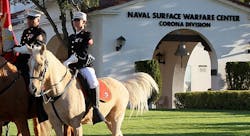U.S. Navy awarded three spectrophotometry patents for threat detection
The Navy was recently awarded three U.S. patents, developed by Naval Surface Warfare Center, Corona Division (Norco, CA), for laser-based air biosensors for remote detection, real-time monitoring and control of biological chemicals including biohazards. The Air Biosensors for Remote Detection of Biohazards will allow the Navy to sample, analyze and send real-time data regarding biological hazards. By analyzing active and passive threats in real time, the devices—including one that enables detection from a remote location—will provide warfighters and first responders significantly more time to seek cover or change into protective gear to avoid dangerous biological hazards.
“These laser-based Air Biosensors for Detection of Biohazards will be important new tools for the warfighter and the Navy,” said Capt. Rick Braunbeck, Commanding Officer of NSWC Corona. “Equipping our warfighters with these innovative technologies will provide them significant advantage in the face of a threat. This is yet another achievement that strengthens the Navy’s intellectual property holdings and adds long-term value to the Navy’s mission.”
By using two common types of laser-based technologies used for chemical detection—molecular absorption spectrophotometry (MAS) and molecular fluorescence spectrophotometry (MFS)—these three devices promise to generate more reliable results than if either technology were used separately.
Two of the three inventions combine the two spectral technologies. The detection capability is based on "label-free" spectrometric signals from native biomolecules. The compact, novel designs are portable; use application-specific scalability of size, weight and power consumption (SWaP); and allow for a long laser path in the air sample for increased sensitivity and selectivity of detection.
The third and latest patent in the series (US 10,209,188 B2) was awarded Feb. 19, 2019 for a novel, compact air biosensor that uses a suction baffle to selectively screen ambient air, including particles and spores, for hazardous biomolecules and bio-agents using the laser-based dual detection technologies (MAS and MFA). This Air Biosensor is designed to mount on and interface with an unmanned aerial vehicle (UAV) or drone that is equipped with GPS, video or still cameras, sensors, and a remote controller for remote operation. It could also attach to a wearable or stationary device.
The second patent (US 10,132,752 B2) was issued Nov. 20, 2018 for a hand-held, laser-based biosensor using molecular fluorescence spectrophotometry for detecting and identifying native biomolecules via direct sampling in solids, fluid, atmospheric air, and on surfaces.
The first patent in this series (US 10,036,703 B1) was awarded July 31, 2018 for a portable, pocket-wearable, laser-based biosensor including interchangeable modular components for the efficient and quick field testing of substances within fluid samples. No such portable biosensor currently exists in the market. Applications include use by first responders, the military, and the food and drug industries.
NSWC Corona is currently pursuing government and industry partnerships to transition these laser-based biosensor concepts into widely available warfighter tools.
"These inventions are win-win outcomes from the summer faculty research program work at NSWC Corona funded by the Office of Naval Research (ONR)," said Dr. Subrata Sanyal, co-inventor and chief scientist in the Measurement Science and Engineering (MS) Department at NSWC Corona. "For the past four summers, the opportunity to work with our ONR summer faculty researcher and co-inventor, Dr. Kin Chiu Ng, an eminent analytical chemistry professor from California State University Fresno, culminated in these inventions for the Navy and a long-term collaboration of mutual benefits. These inventions have great technical potential for warfighters and mankind, when deployed."
The latest Patent Power Scorecard (2017) published by the Institute of Electrical Engineers ranks the Navy’s patent portfolio second in the world amongst all other government agencies, a distinction fueled by employees and contractors across the Navy’s science and engineering enterprise.
SOURCE: Naval Surface Warfare Center Corona; https://www.navsea.navy.mil/Media/News/

Gail Overton | Senior Editor (2004-2020)
Gail has more than 30 years of engineering, marketing, product management, and editorial experience in the photonics and optical communications industry. Before joining the staff at Laser Focus World in 2004, she held many product management and product marketing roles in the fiber-optics industry, most notably at Hughes (El Segundo, CA), GTE Labs (Waltham, MA), Corning (Corning, NY), Photon Kinetics (Beaverton, OR), and Newport Corporation (Irvine, CA). During her marketing career, Gail published articles in WDM Solutions and Sensors magazine and traveled internationally to conduct product and sales training. Gail received her BS degree in physics, with an emphasis in optics, from San Diego State University in San Diego, CA in May 1986.
